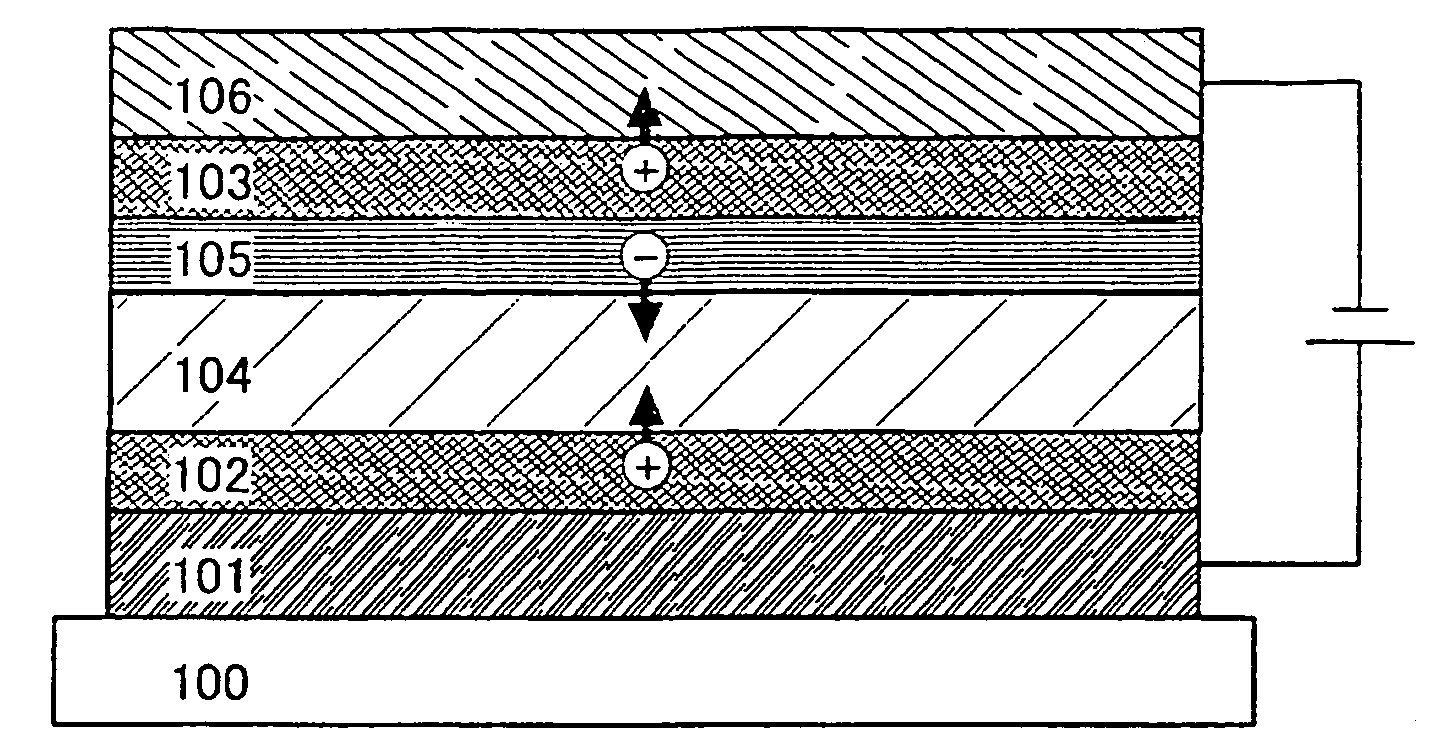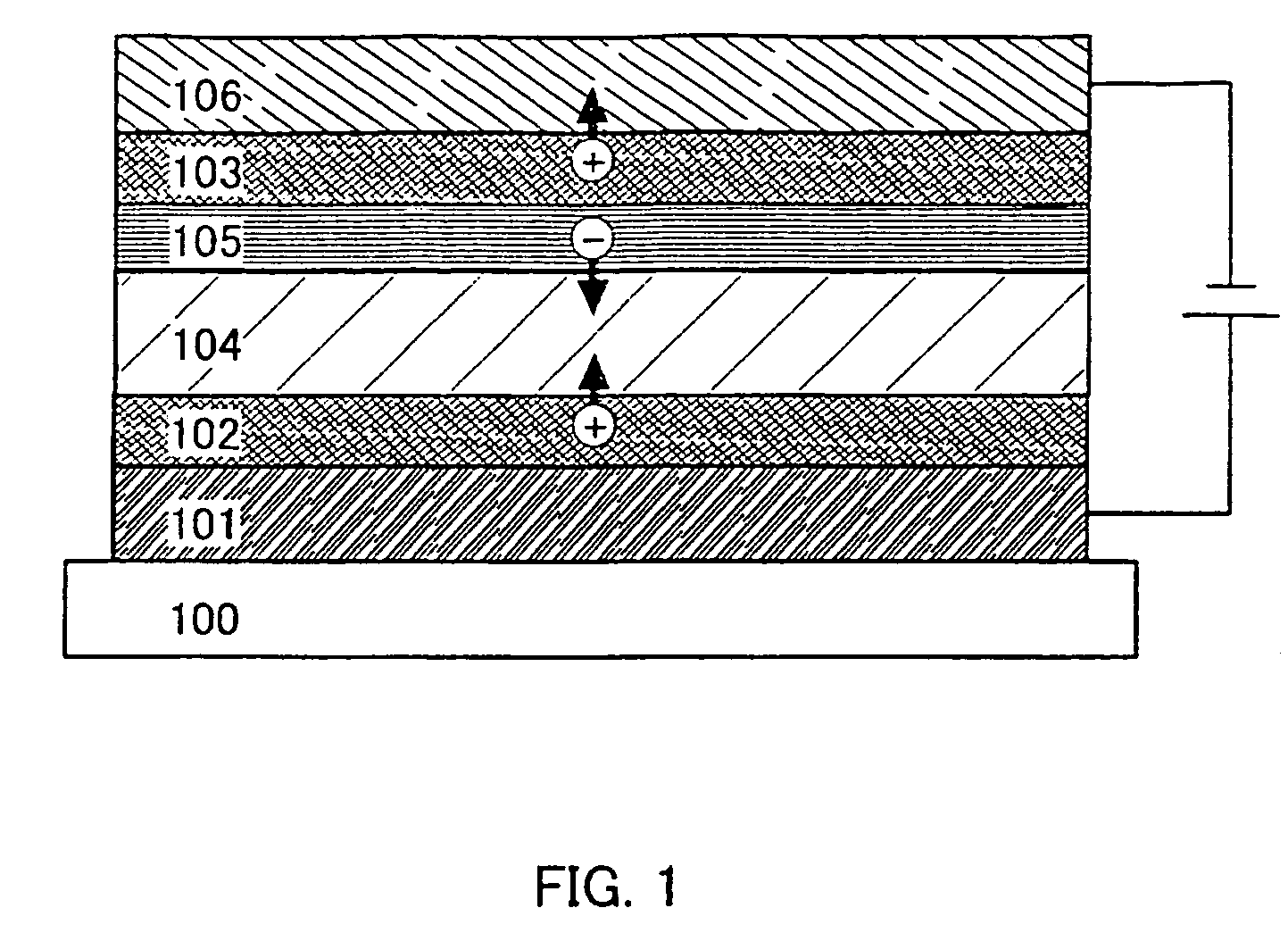Light emitting element
a technology of light-emitting elements and organic compounds, which is applied in the direction of discharge tube luminescnet screens, organic semiconductor devices, natural mineral layered products, etc., can solve the problems of limited material mainly containing organic compounds which can transport electrons at a predetermined mobility or more, and achieve the effects of reducing the drive voltage, reducing the stress of the light-emitting layer, and suppressing the increase in the drive voltage over tim
- Summary
- Abstract
- Description
- Claims
- Application Information
AI Technical Summary
Benefits of technology
Problems solved by technology
Method used
Image
Examples
embodiment mode 1
[0042]In the present embodiment mode, structures of a light-emitting element of the present invention will be described with reference to FIGS. 1 and 2. In a light-emitting element according to the present invention, a light-emitting layer 104 containing a light-emitting material and an electron-generating layer 105 are stacked, and the light-emitting layer 104 and the electron-generating layer 105 are provided between a first hole-generating layer 102 and a second hole-generating layer 103. The first hole generating layer 102 is in contact with a first electrode, and the second hole generating layer 103 is in contact with a second electrode. The first hole-generating layer 102 and the second hole-generating layer 103 are further provided between the first electrode 101 and the second electrode 106, and stacked over an insulator 100 such as a substrate or an insulating film. Over the insulator 100 such as the substrate or the insulating film, the first electrode 101, the first hole-...
embodiment mode 2
[0057]Another embodiment mode of the present invention will be described. The present embodiment mode describes an example of improving the characteristic of a viewing angle of a light-emitting element and a display device by appropriately adjusting the thicknesses of the first hole-generating layer 102 and the second hole-generating layer 103. Since the layered structure and the material of the light-emitting element in the present embodiment mode are the same as those in Embodiment Mode 1, the description is omitted here. Refer to Embodiment Mode 1. Note that, also in the present embodiment mode, when voltage is applied so as to make a light emitting element emit light, the electrode applied with higher potential is the first electrode, and the electrode applied with lower potential is the second electrode.
[0058]Light emitted from the light-emitting element includes light directly emitted from the light-emitting layer 104 and light emitted after being reflected once or multiple ti...
embodiment mode 3
[0074]This embodiment mode will describe a display device according to the present invention shown in Embodiment Mode 1 or Embodiment Mode 2 while showing its manufacturing method with reference to FIGS. 5A to 6C. Although this embodiment mode shows an example of manufacturing an active matrix display device, a light-emitting element of the present invention is also applicable for a passive matrix display device.
[0075]First, a first base insulating layer 51a and a second base insulating layer 51b are formed over a substrate 50, and then a semiconductor layer is formed over the second base insulating layer 51b (FIG. 5A).
[0076]As a material of the substrate 50, glass, quartz, plastic (such as polyimide, acrylic, polyethylene terephthalate, polycarbonate, polyacrylate, or polyethersulfone), or the like can be used. These substrates may be used after being polished by CMP or the like as necessary. In this embodiment mode, a glass substrate is used.
[0077]The first base insulating layer 5...
PUM
 Login to View More
Login to View More Abstract
Description
Claims
Application Information
 Login to View More
Login to View More - R&D
- Intellectual Property
- Life Sciences
- Materials
- Tech Scout
- Unparalleled Data Quality
- Higher Quality Content
- 60% Fewer Hallucinations
Browse by: Latest US Patents, China's latest patents, Technical Efficacy Thesaurus, Application Domain, Technology Topic, Popular Technical Reports.
© 2025 PatSnap. All rights reserved.Legal|Privacy policy|Modern Slavery Act Transparency Statement|Sitemap|About US| Contact US: help@patsnap.com



